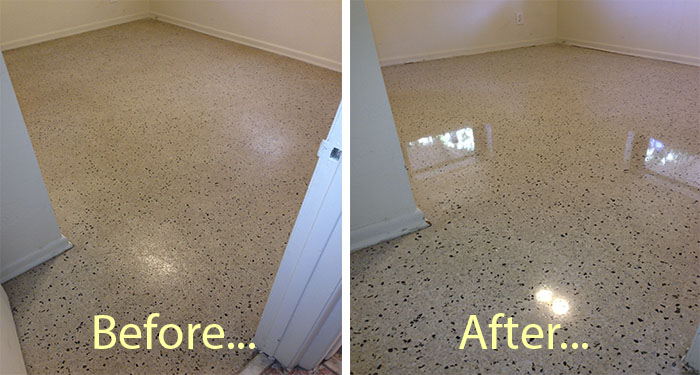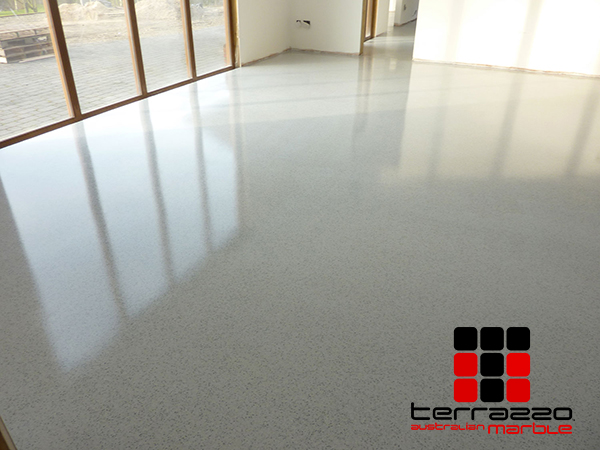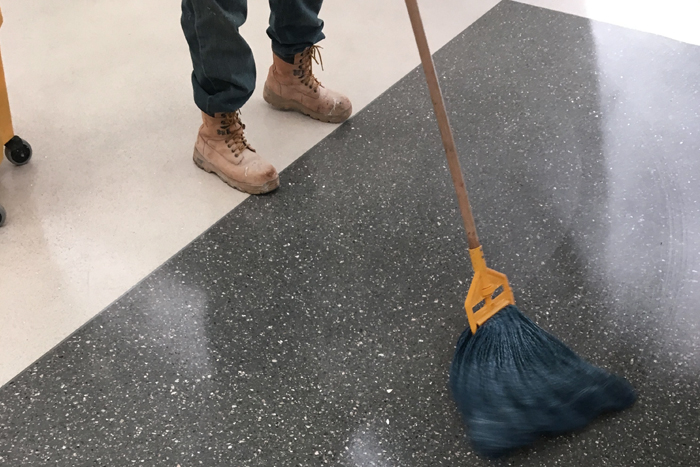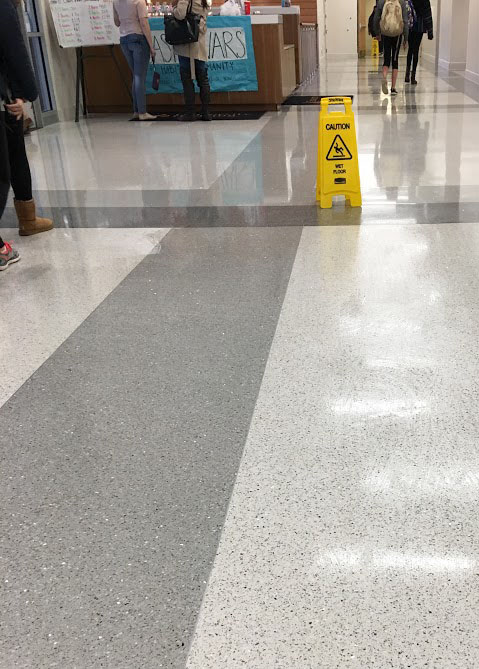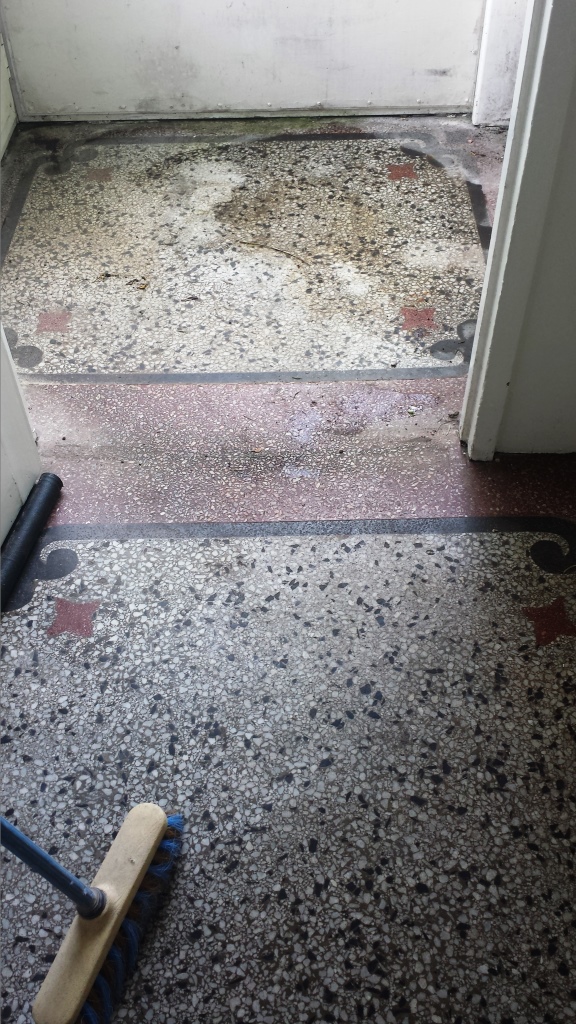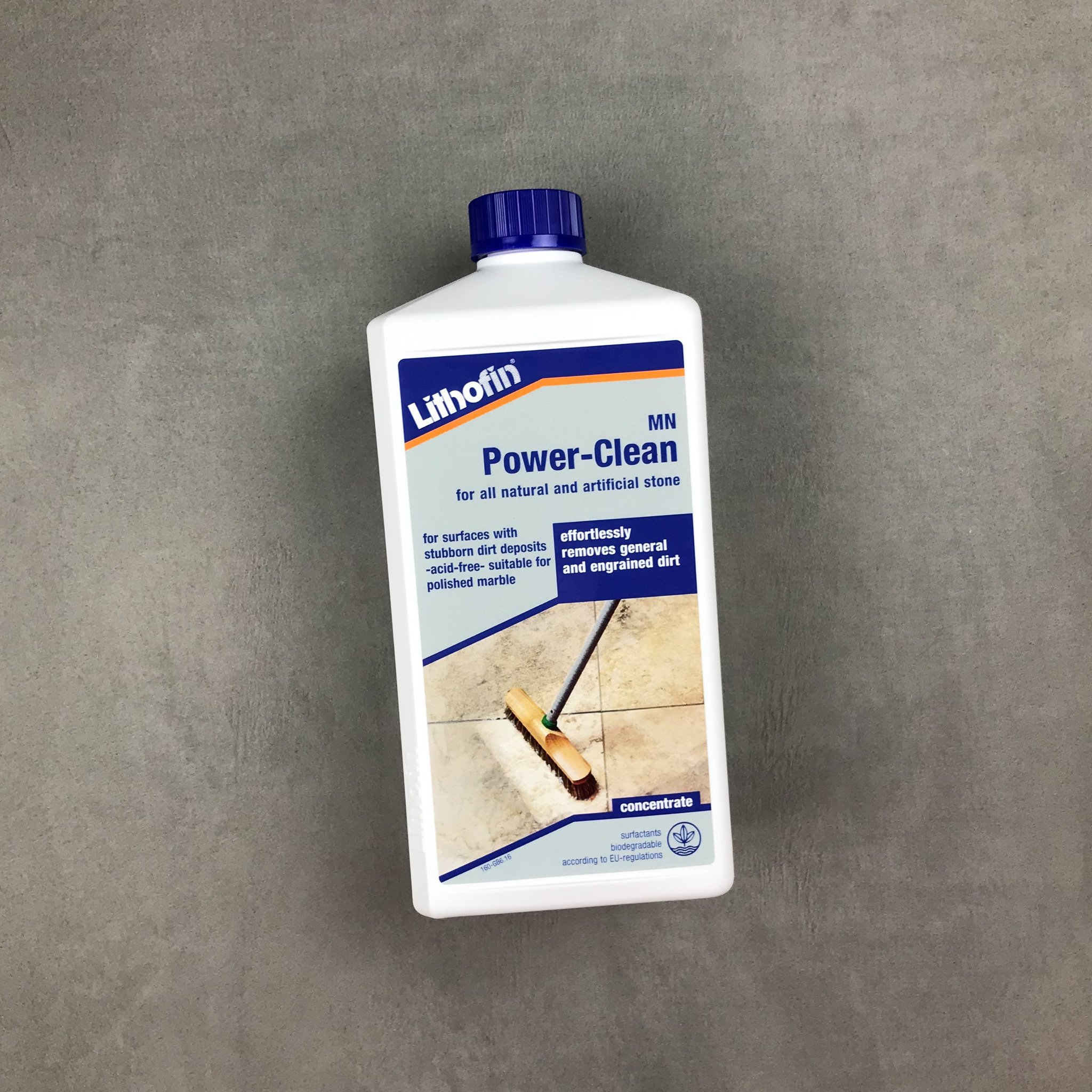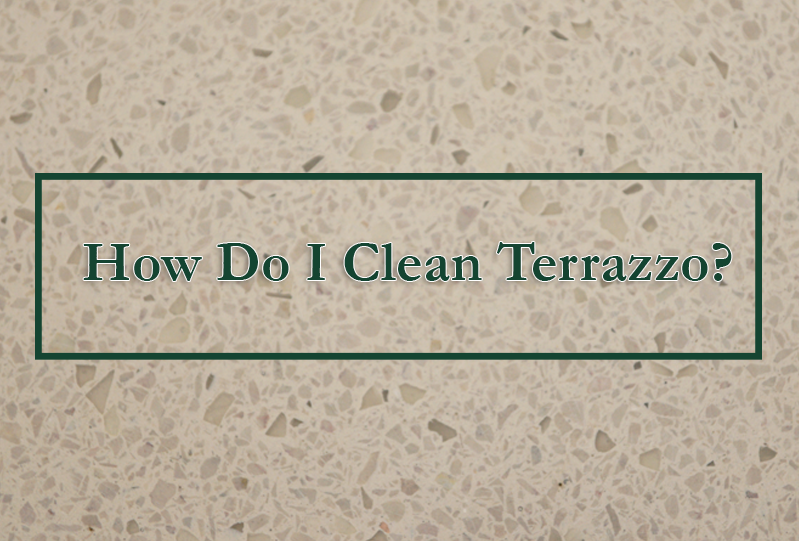Understanding Terrazzo Tile Floors
Terrazzo tile floors have been a popular choice for decades due to their durability, timeless aesthetic, and versatility. Understanding the composition and characteristics of terrazzo tile floors is essential for proper maintenance and care.
- Composition: Terrazzo tile floors are composed of a mixture of marble, granite, quartz, or glass chips embedded in a cement or epoxy binder. This mixture is poured, cured, and polished to create a smooth and seamless surface. The variety of materials used in terrazzo tiles allows for a wide range of colors, patterns, and finishes to suit any design aesthetic.
- Characteristics: One of the key characteristics of terrazzo tile floors is their durability. They are resistant to stains, scratches, and moisture, making them ideal for high-traffic areas such as lobbies, hallways, and commercial spaces. Additionally, terrazzo tile floors are easy to clean and maintain, requiring minimal effort to keep them looking their best.
- Aesthetic Appeal: Terrazzo tile floors are known for their timeless beauty and elegance. The combination of natural stone chips and the polished finish creates a luxurious and sophisticated look that adds value to any space. Whether used in contemporary or traditional settings, terrazzo tile floors make a bold statement and elevate the overall design aesthetic.
- Versatility: Another advantage of terrazzo tile floors is their versatility. They can be customized to suit any design vision, whether it’s a minimalist monochromatic palette or a vibrant mosaic of colors and patterns. Terrazzo tiles come in various sizes and shapes, allowing for endless design possibilities to create unique and stunning floor installations.
- Sustainability: Terrazzo tile floors are also an environmentally friendly choice. They are made from natural and recycled materials, reducing the need for new resources. Additionally, the longevity of terrazzo tile floors means they require less frequent replacement, further reducing their environmental impact.

Essential Tools and Supplies for Cleaning Terrazzo Tile Floors
Cleaning terrazzo tile floors requires the right tools and supplies to ensure effective and safe maintenance. From gentle cleansers to specialized equipment, having the essential items on hand will make the cleaning process more efficient and help preserve the beauty of your terrazzo tile floors.
Soft Bristle Broom: Start by removing loose dirt and debris from the surface of your terrazzo tile floors with a soft bristle broom. Avoid using stiff brushes or abrasive tools that could scratch the surface.
Neutral pH Cleaner: Choose a gentle, neutral pH cleaner specifically formulated for terrazzo tile floors. Avoid harsh chemicals or acidic cleaners that can damage the finish and compromise the integrity of the tiles.
Microfiber Mop: Use a microfiber mop with a gentle cleaning solution to effectively clean and remove dirt and grime from terrazzo tile floors. Microfiber mops are ideal for trapping dust and debris without leaving behind streaks or residue.
Soft Cloth or Sponge: For spot cleaning or addressing spills, having a soft cloth or sponge is essential for preserving the beauty and integrity of your terrazzo tile floors. Here are some troubleshooting tips for tackling tough stains and grime on terrazzo tile floors:
Oil-Based Stains: For oil-based stains such as grease or cooking oil, start by blotting up as much of the stain as possible with a clean cloth or paper towel. Then, sprinkle baking soda or cornstarch over the stain to absorb the remaining oil. Let it sit for 15-20 minutes, then sweep or vacuum up the powder. Finally, clean the area with a mild detergent solution and rinse thoroughly with water.
Water-Based Stains: Water-based stains such as coffee, tea, or juice can usually be removed with a mixture of mild detergent and water. Apply the solution to the stained area and gently scrub with a soft brush or cloth. Rinse thoroughly with water and dry the area completely.
Organic Stains: Organic stains such as food, wine, or pet accidents can be treated with a solution of white vinegar and water. Mix equal parts vinegar and water, apply to the stained area, and let it sit for 5-10 minutes. Gently scrub with a soft brush or cloth, then rinse thoroughly with water and dry completely.
Mineral Deposits: Mineral deposits such as calcium or lime buildup can be removed with a solution of white vinegar and water. Apply the solution to the affected area and let it sit for 5-10 minutes. Gently scrub with a soft brush or cloth, then rinse thoroughly with water and dry completely.
Rust Stains: Rust stains can be challenging to remove from terrazzo tile floors. Try using a commercial rust remover specifically formulated for use on natural stone surfaces. Follow the manufacturer’s instructions carefully and test the product in a small, inconspicuous area before applying it to the entire stain.
Grout Stains: Grout stains can be removed with a mixture of baking soda and water. Apply the paste to the stained grout lines and let it sit for 15-20 minutes. Gently scrub with a soft brush or toothbrush, then rinse thoroughly with water and dry completely.
Etching: Etching, or dull spots on the surface of terrazzo tile floors, can be caused by acidic spills or harsh cleaning chemicals. To repair the etching, lightly sand the affected area with fine-grit sandpaper until the surface is smooth and even. Clean the area with a mild detergent solution, rinse thoroughly with water, and dry completely.
Prevention: To prevent future stains and grime buildup on your terrazzo tile floors, consider applying a penetrating sealer to protect the surface. Additionally, establish a regular maintenance schedule for cleaning and maintaining your floors to prevent stains and grime from becoming permanent.
Step-by-Step Guide: Cleaning and Maintaining Terrazzo Tile Floors
Cleaning and maintaining terrazzo tile floors is a straightforward process that can be easily incorporated into your regular cleaning routine. By following a few simple steps, you can keep your terrazzo tile floors looking their best and ensure their longevity.
Sweep or Vacuum: Start by removing loose dirt and debris from the surface of your terrazzo tile floors using a soft bristle broom or vacuum cleaner. Pay special attention to corners and edges where dirt and dust tend to accumulate.
Prepare Cleaning Solution: Mix a gentle, neutral pH cleaner with water according to the manufacturer’s instructions. Avoid using harsh chemicals or acidic cleaners that can damage the finish of the terrazzo tiles.
Mop the Floors: Use a microfiber mop dampened with the cleaning solution to mop the terrazzo tile floors. Work in small sections, overlapping each pass to ensure thorough coverage. Avoid using excessive water, as it can seep into the grout lines and cause damage over time.
Spot Clean Stains: For stubborn stains or spills, apply a small amount of the cleaning solution directly to the affected area and gently scrub with a soft cloth or sponge. Avoid using abrasive tools or harsh chemicals that could damage the surface of the terrazzo tiles.
Rinse the Floors: Once you’ve cleaned the entire surface of the terrazzo tile floors, rinse thoroughly with clean water to remove any residue from the cleaning solution. Use a separate mop or clean cloth dampened with water for rinsing.
Dry the Floors: Use a clean, dry microfiber mop or towel to dry the terrazzo tile floors thoroughly. Avoid leaving any standing water on the surface, as it can cause water spots and streaks.
Apply Sealer (if applicable): Depending on the type of terrazzo tiles you have, consider applying a sealer to protect the surface from stains and moisture penetration. Follow the manufacturer’s instructions for application and reapplication as needed.
Regular Maintenance: Establish a regular maintenance schedule for cleaning and maintaining your terrazzo tile floors. Sweep or vacuum regularly to remove dirt and debris, and clean spills promptly to prevent staining or damage.
Troubleshooting Tips for Tough Stains and Grime on Terrazzo Tile Floors
Despite regular cleaning and maintenance, terrazzo tile floors may occasionally encounter tough stains and grime that require extra attention. Knowing how to troubleshoot these issues is essential for preserving the beauty and integrity of your terrazzo tile floors.
Oil-Based Stains: For oil-based stains such as grease or cooking oil, start by blotting up as much of the stain as possible with a clean cloth or paper towel. Then, sprinkle baking soda or cornstarch over the stain to absorb the remaining oil. Let it sit for 15-20 minutes, then sweep or vacuum up the powder. Finally, clean the area with a mild detergent solution and rinse thoroughly with water.
Water-Based Stains: Water-based stains such as coffee, tea, or juice can usually be removed with a mixture of mild detergent and water. Apply the solution to the stained area and gently scrub with a soft brush or cloth. Rinse thoroughly with water and dry the area completely.
Organic Stains: Organic stains such as food, wine, or pet accidents can be treated with a solution of white vinegar and water. Mix equal parts vinegar and water, apply to the stained area, and let it sit for 5-10 minutes. Gently scrub with a soft brush or cloth, then rinse thoroughly with water and dry completely.
Mineral Deposits: Mineral deposits such as calcium or lime buildup can be removed with a solution of white vinegar and water. Apply the solution to the affected area and let it sit for 5-10 minutes. Gently scrub with a soft brush or cloth, then rinse thoroughly with water and dry completely.
Rust Stains: Rust stains can be challenging to remove from terrazzo tile floors. Try using a commercial rust remover specifically formulated for use on natural stone surfaces. Follow the manufacturer’s instructions carefully and test the product in a small, inconspicuous area before applying it to the entire stain.
Grout Stains: Grout stains can be removed with a mixture of baking soda and water. Apply the paste to the stained grout lines and let it sit for 15-20 minutes. Gently scrub with a soft brush or toothbrush, then rinse thoroughly with water and dry completely.
Etching: Etching, or dull spots on the surface of terrazzo tile floors, can be caused by acidic spills or harsh cleaning chemicals. To repair etching, lightly sand the affected area with fine-grit sandpaper until the surface is smooth and even. Clean the area with a mild detergent solution, rinse thoroughly with water, and dry completely.
Prevention: To prevent future stains and grime buildup on your terrazzo tile floors, consider applying a penetrating sealer to protect the surface. Additionally, establish a regular maintenance schedule for cleaning and maintaining your floors to prevent stains and grime from becoming permanent.
Long-Term Care and Preservation of Terrazzo Tile Floors
Long-term care and preservation of terrazzo tile floors are essential for maintaining their beauty and integrity over time. By following a few simple steps and incorporating regular maintenance into your cleaning routine, you can ensure that your terrazzo tile floors remain in top condition for years to come.
Regular Maintenance: Establish a regular maintenance schedule for cleaning and maintaining your terrazzo tile floors. Sweep or vacuum regularly to remove dirt and debris, and clean spills promptly to prevent staining or damage.
Protective Mats and Furniture Pads: Use protective mats or furniture pads under heavy furniture and in high-traffic areas to prevent scratches and damage to your terrazzo tile floors. This will help distribute weight evenly and reduce the risk of indentations or scratches.
Avoid Harsh Chemicals: Avoid using harsh chemicals or abrasive cleaners on terrazzo tile floors, as they can damage the finish and compromise the integrity of the tiles. Stick to gentle, neutral pH cleaners specifically formulated for terrazzo tile floors.
Regular Sealing: Depending on the type of terrazzo tiles you have, consider applying a penetrating sealer every few years to protect the surface from stains and moisture penetration. Follow the manufacturer’s instructions for application and reapplication as needed.
Preventive Measures: Take preventive measures to protect your terrazzo tile floors from potential damage. Use felt pads on the bottom of furniture legs to prevent scratching, and avoid dragging heavy objects across the surface.
Professional Maintenance: Periodically, consider hiring a professional to deep clean and polish your terrazzo tile floors. Professional cleaning and maintenance can help remove stubborn stains and grime buildup, as well as restore the shine and luster of the tiles.
Regular Inspections: Conduct regular inspections of your terrazzo tile floors to check for any signs of damage or wear. Address any issues promptly to prevent them from worsening over time.
Cleaning Terrazzo Floors, How to Clean Terrazzo Floors, Terrazzo
How Do I Clean a Terrazzo Floor LoveToKnow
How To Care u0026 Maintain For Terrazzo Floors – TM Supply
Terrazzo Floor Maintenance and Cleaning Doyle Dickerson Terrazzo
How To Clean Terrazzo Floor Services in Ft Lauderdale – YouTube
How to Clean, Paint u0026 Polish Your Terrazzo Flooring?
Restoring an old Terrazzo floor – Stone Cleaning and Polishing
How to clean Terrazzo Tiles
How Do I Clean Terrazzo Floors? Doyle Dickerson Terrazzo
Related Posts:


